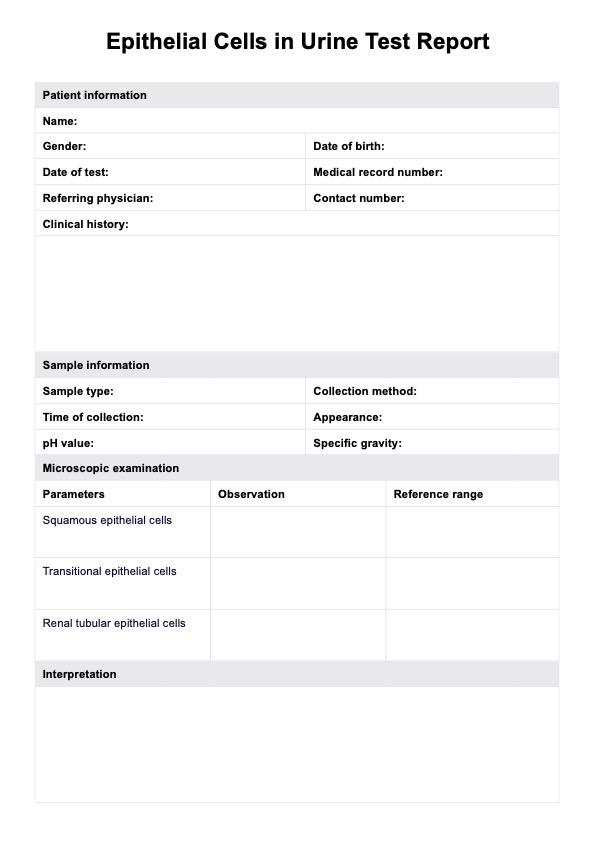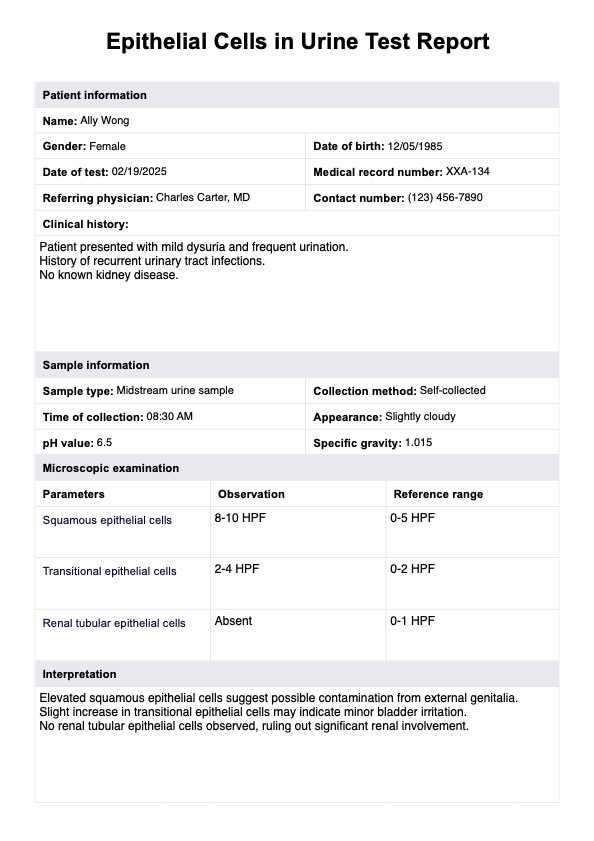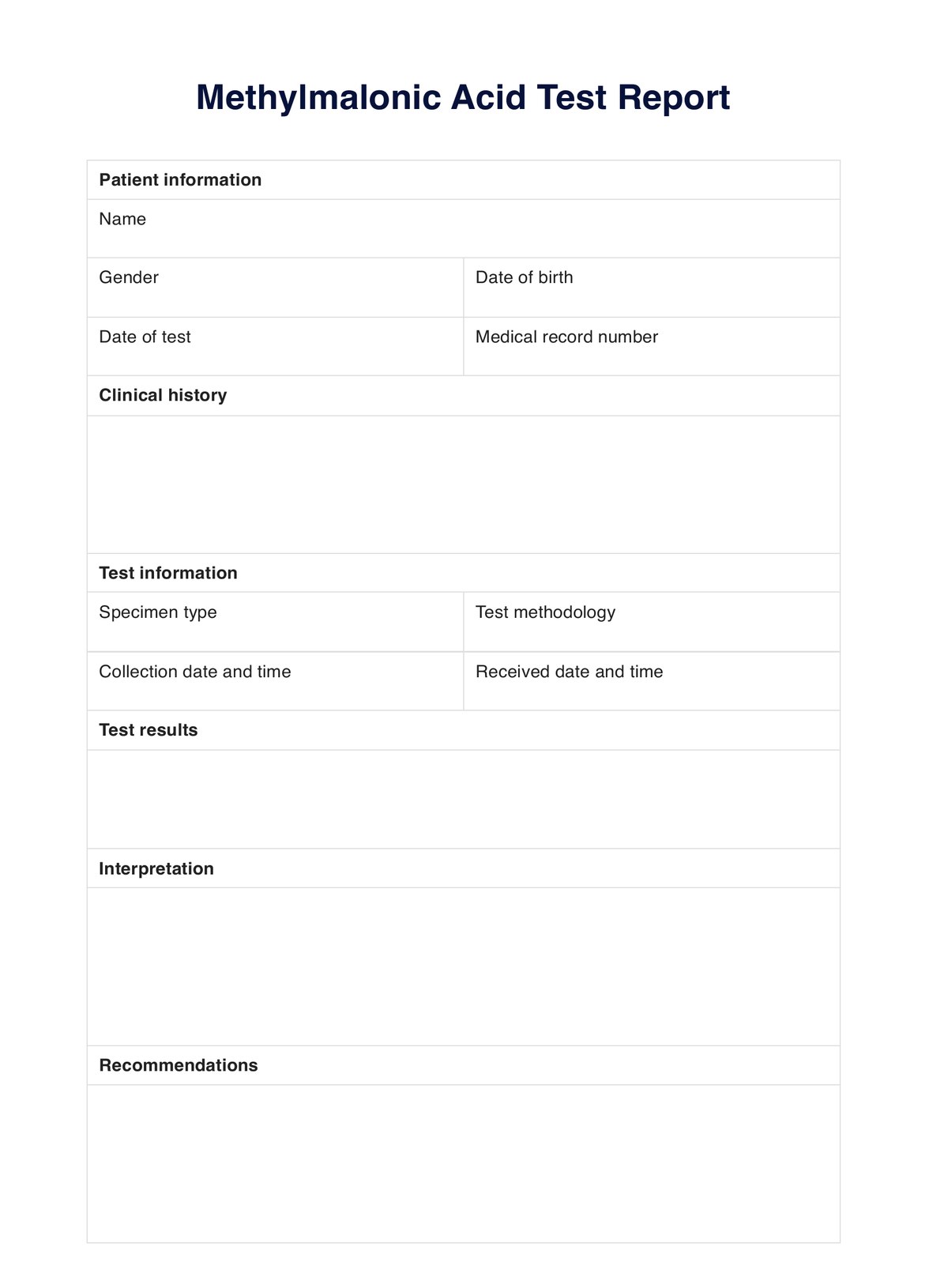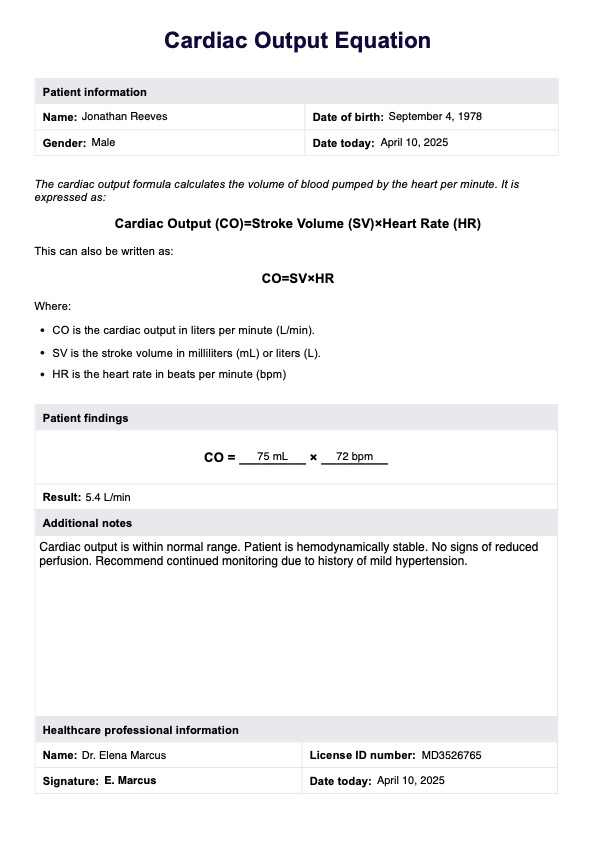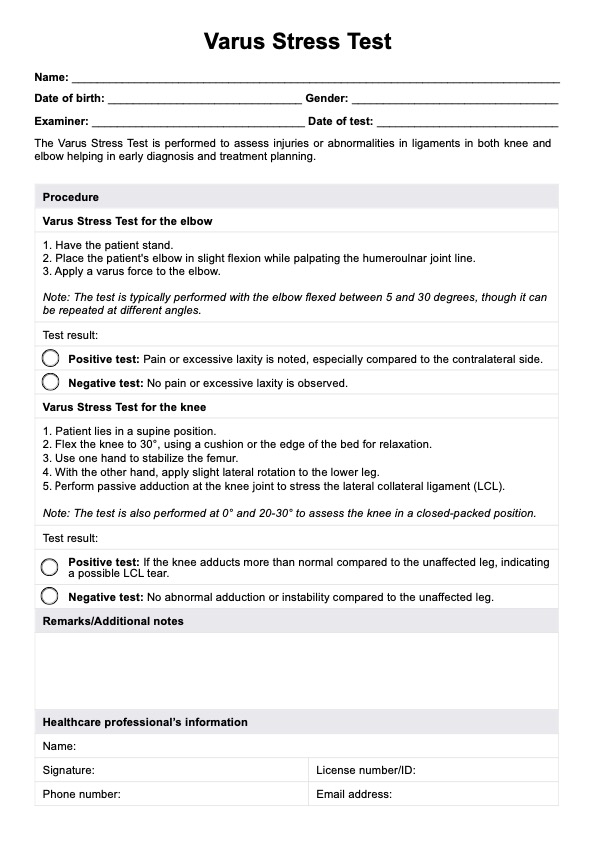Epithelial Cells in Urine Test Reports
Learn about Epithelial Cells in Urine Tests and use our free report template to document findings. Get the PDF template here.


What is an epithelial cells in urine test?
An epithelial cells in urine test is a diagnostic tool used to detect the presence and quantity of epithelial cells in urine. These cells naturally shed from the urinary tract, but an excessive amount may indicate underlying health conditions such as urinary tract infections (UTIs), kidney disease, or chronic inflammation (Burgess & Grayland-Leech, 2024).
Epithelial cells line the body's surface, acting as a protective barrier. There are three types of epithelial cells, these are listed below (Burgess & Grayland-Leech, 2024):
- Squamous epithelial cells:These are the largest type of epithelial cells and are primarily found in the vagina, urethra, and external genitalia. Their presence in urine is usually not a concern unless found in high quantities, which may indicate contamination or infection.
- Transitional epithelial cells: These are located between the renal pelvis and urethra and are commonly shed due to natural turnover. However, large numbers may suggest urinary tract infections, bladder inflammation, or even malignancies.
- Renal epithelial cells: These originate from the kidneys and should be minimal or absent in healthy urine samples. The presence of renal epithelial cells may indicate kidney damage, chronic kidney disease (CKD), or acute tubular injury.
An epithelial cells in urine test involves collecting a midstream urine sample, which is analyzed under a microscope. A urinalysis will assess:
- The number and type of epithelial cells present
- Red blood cells, white blood cells, and protein levels
- Signs of infection, kidney disease, or urinary tract damage
Healthcare providers then record the results in an Epithelial Cells in Urine Test Report, which summarizes the findings and any relevant information for healthcare providers to diagnose and treat the patient properly.
Epithelial Cells in Urine Test Reports Template
Epithelial Cells in Urine Test Reports Example
How does our Epithelial Cells in Urine Test Report work
Our free Epithelial Cells in Urine Test Report template lets you document your patient's test results in minutes. Here's how to use the printable template:
Step 1: Access the report
Access the Epithelial Cells in Urine Test Report template by clicking "Use a template," allowing you to edit the resource via the Carepatron app. For a PDF copy, choose "Download."
Step 2: Fill in the patient's information
Enter the patient's name, birth date, and other relevant details. Make sure to double-check for accuracy.
Step 3: Document the test results
Document the test results and any crucial findings or observations using clear and concise language. You may also include any relevant medical history or symptoms reported by the patient.
Step 4: Provide recommendations
If necessary, provide recommendations for further treatment or follow-up tests based on the test results. Include instructions or reminders for the patient to ensure proper care and management.
Step 5: Save and share
Once completed, save the report and share it with the patient's healthcare team. You can also keep a copy of their electronic health records for future reference.
When would you use this report template?
You can use the Epithelial Cells in Urine Test Report template anytime you need to document and share the results of a urine test with a patient's healthcare team. This may include routine check-ups, diagnosing a potential health condition, or monitoring an existing condition. Moreover, you can use this template to:
Track changes in epithelial cell levels over time
Our Epithelial Cells in Urine Test Report template lets you easily compare test results from previous visits. This allows you to monitor changes in epithelial cell levels and possible patient health implications.
Educate patients about their test results
The report template includes clear and concise explanations of the test results, making it a valuable tool for patient education. You can use this template to explain the significance of epithelial cells in urine and how changes in levels may indicate underlying health issues.
Collaborate with other healthcare professionals
Our Epithelial Cells in Urine Test Report can be easily shared with the patient's healthcare team, allowing for better collaboration and care coordination. Other medical professionals can easily understand and interpret the results with the technical language used in the report and its organized format.
Keep a detailed record of test results
Using this report template, you can maintain a comprehensive and organized record of the patient's urine test results. This can be helpful for future reference or when monitoring the effectiveness of treatments over time.
What do the results mean?
Understanding the results of an epithelial cells in urine test is crucial in identifying potential health conditions affecting the urinary tract, kidneys, or blood vessels. Normal urine samples contain a small number of epithelial cells, including transitional cells from the bladder and squamous epithelial cells from the external urethra (Burgess & Grayland-Leech, 2024).
An increase in epithelial cell count above the normal range may indicate kidney disease, urinary tract infections (UTIs), kidney stones, inflammation, or even early-stage cancer.
Test results are typically classified into three categories: few, moderate, and many, helping healthcare providers determine the severity and possible causes of elevated epithelial cells (Garg, 2022).
- Few: This is considered a normal range for individuals of all ages and genders. A healthy urinary system should contain less than 15–20 squamous epithelial cells per HPF (high power field). At this level, there is no abnormal shedding of epithelial cells, indicating proper kidney and urinary tract function.
- Moderate: If more than 15–20 squamous epithelial cells per HPF are present, it may indicate inflammation, irritation, or mild infection. This could be due to a urinary tract infection (UTI), kidney disease, or kidney stones. Additionally, moderate levels of renal tubular epithelial cells may suggest early signs of kidney damage or high blood pressure-related kidney dysfunction.
- Many: A significantly high level of epithelial cells in urine, particularly renal tubular epithelial cells, may indicate serious conditions such as chronic kidney disease, severe infections, or even malignancy. For example, A urine test revealed squamous epithelial cells present in the sample, which may indicate contamination or an underlying urinary tract condition that requires further evaluation.
- In some cases, damaged blood vessels in the kidneys due to hypertension or kidney stones can lead to an increased presence of renal epithelial cells, signaling renal injury or declining kidney function.
Results may vary depending on age, gender, and underlying health conditions. To ensure accuracy, patients should follow pre-test guidelines (e.g., proper sample collection techniques) and undergo additional diagnostic tests, such as urinalysis, blood pressure monitoring, and kidney function tests, to confirm any underlying issues.
References
Burgess, L., & Grayland-Leech, B. (2024). What do epithelial cells in urine mean? MedicalNewsToday. https://www.medicalnewstoday.com/articles/321295#testing
Garg, P. (2022). Epithelial cells in urine: Normal range, treatment, risk factors. Redcliffe labs.
Commonly asked questions
An epithelial cells in urine test may be ordered during a routine checkup or if initial urine tests show abnormalities. It's commonly used to investigate symptoms of urinary or kidney disorders, such as frequent or painful urination, abdominal pain, back pain, or blood in the urine.
Typically, no special preparations are required, but if other urine or blood tests are being taken, it is sometimes necessary to fast for several hours beforehand. It also may be necessary to stop taking certain medications. Consulting with a medical professional is essential to determine any specific instructions required for the test.
The test is performed by collecting a clean-catch urine sample. This involves using a sterile container to capture midstream urine, which minimizes contamination. The sample is then sent to a laboratory, where it is analyzed under a microscope to check for the presence and quantity of epithelial cells.


